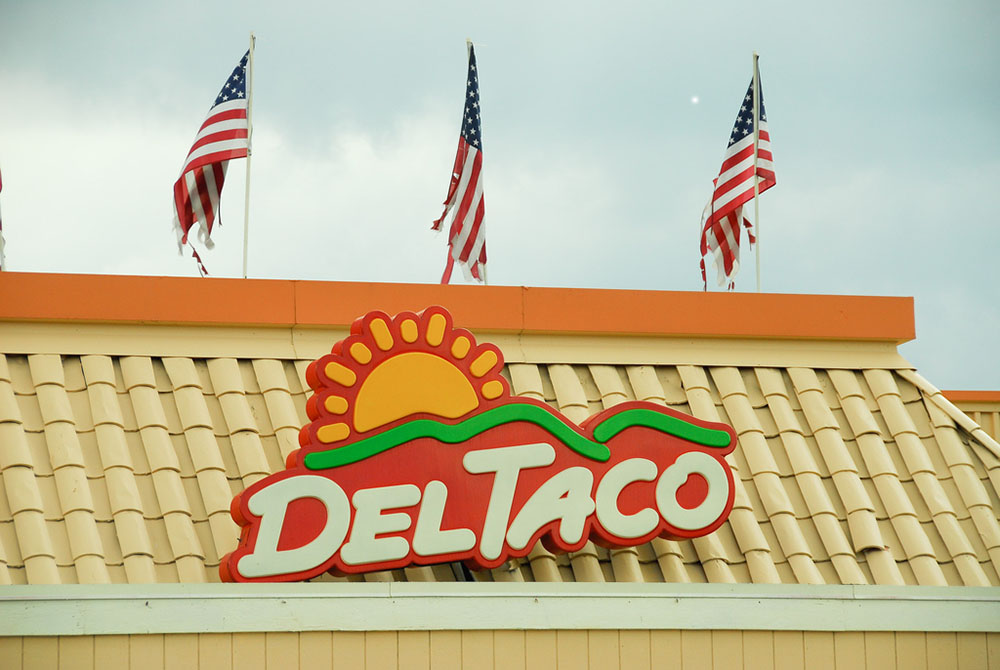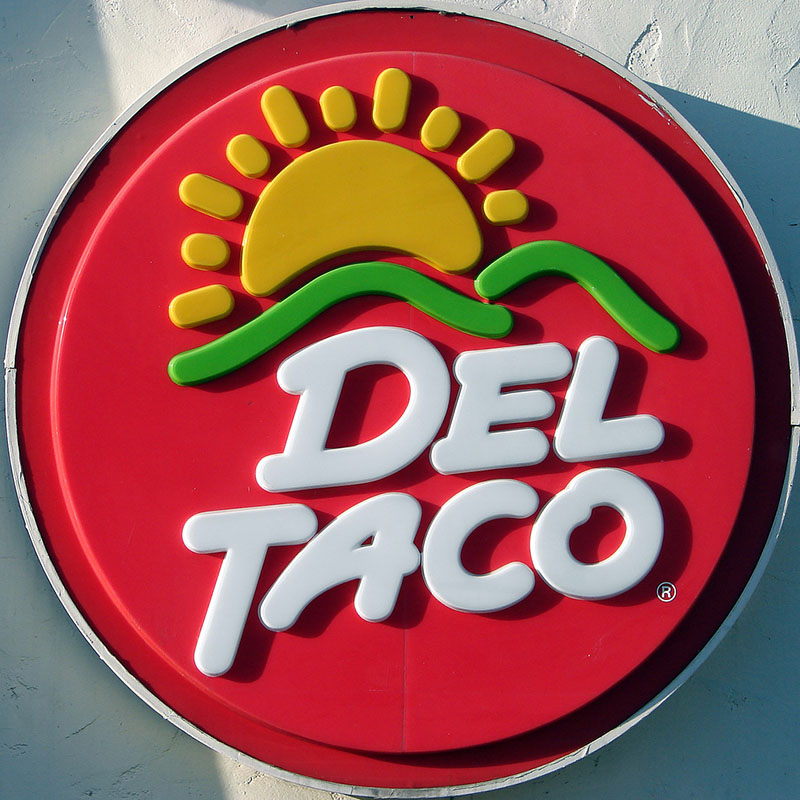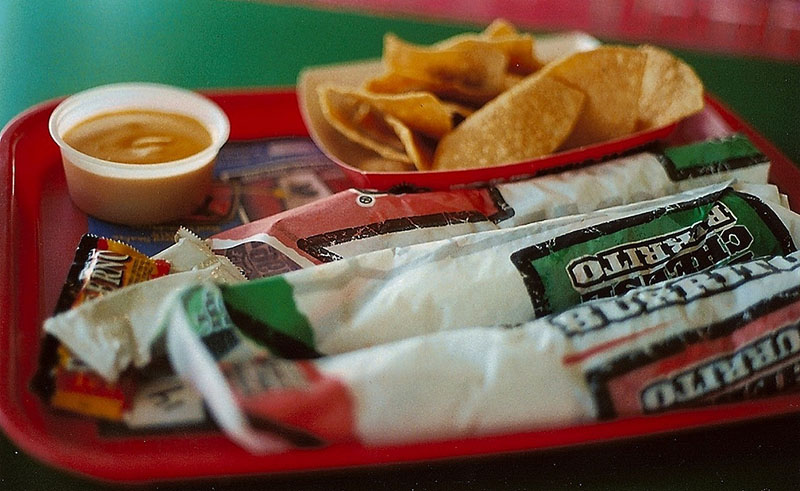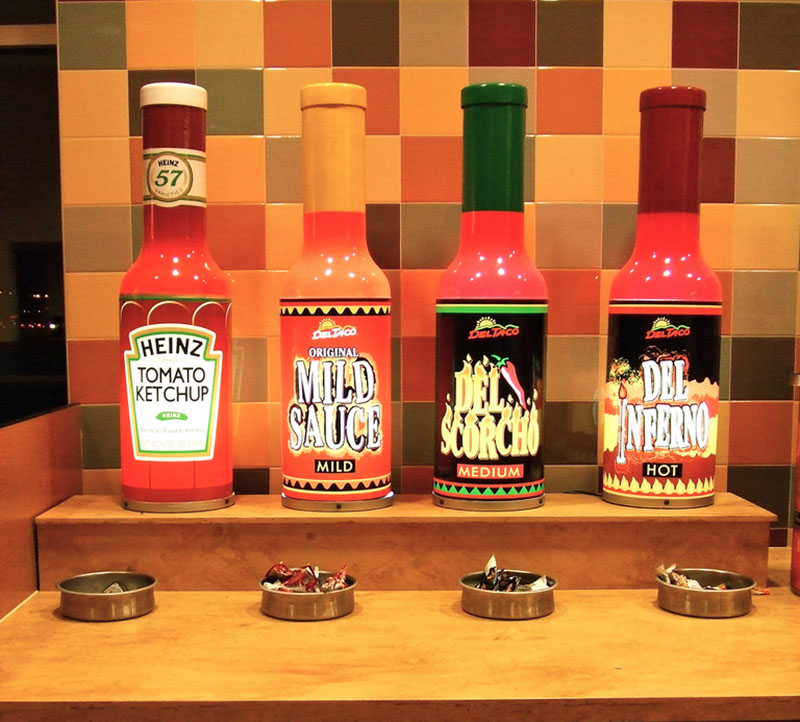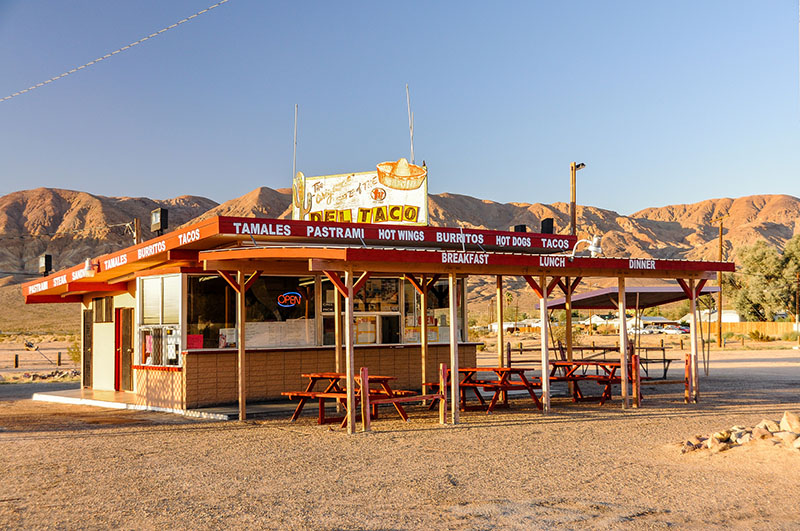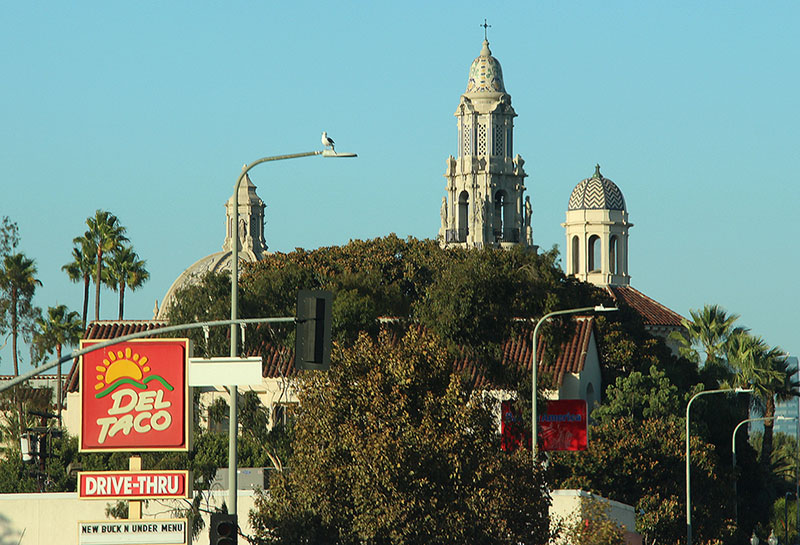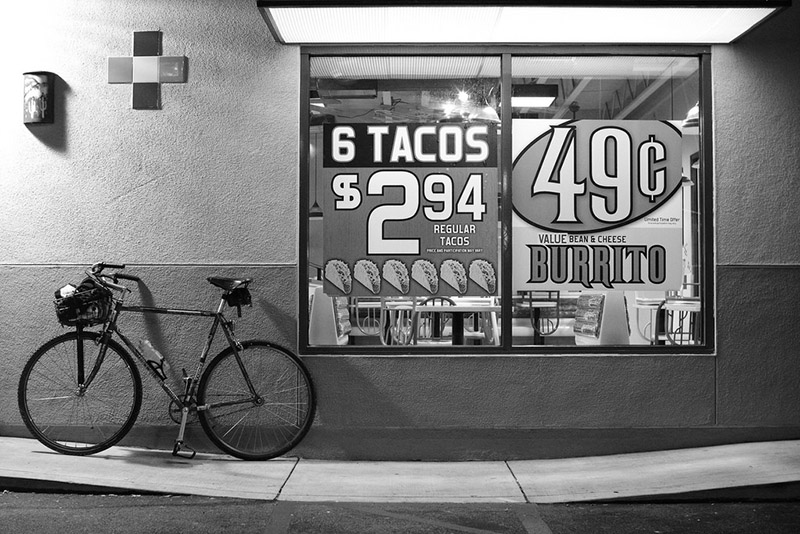We’ll go to Del Taco,
And order something macho.
And when your lips go down to take a bite,
Your face is covered in food but it’s alright,
You know it’s gonna be good, you and me tonight.
─ Hunx and His Punx “Good Kisser”
The day my friend Rich bought a Del Taco T-shirt from an employee was the day I realized that my fixation with the fast food Mexican chain was about more than beans. Back then, in 1993, I was an 18-year-old Arizonan obsessed with California beach culture. I owned a boogie board that I used one week a year. I wore vintage Hang Ten and Hobie surf tees that I found at Phoenix thrift stores. I favored Van’s and cutoffs, and I rode a late ’60s red and white Schwinn beach cruiser whose sleek beauty and tall white walls had strangers yelling “Hey, Pee Wee Herman!” at me on the street. If the southern California coast was the center of my landlocked universe, then Del Taco was a bright star in my sky. What did I know? Fresh out of high school and uncertain about the future, I was searching for an identity. All I knew for certain was that I wanted to live on the beach.
After a trip to Malibu in fifth grade, I decided I belonged in southern California. I covered my bedroom walls with images clipped from surf magazines. I stuck corny neon Body Glove and Mr. Zog’s Sex Wax stickers on my door, even though I never needed either company’s gear. Next to them, I taped a quotation from an advertisement: “Summer is an attitude, not a season.” That sounded great in the desert heat, but it caused static in my mind, because it pitted my desire against reality. I wasn’t in California. I was in Phoenix. Instead of calmly accepting this fact, I lived in my imagination and waited for the release of summer trips.
As much as I liked it, Del Taco’s food wasn’t the draw. We had refried beans and thin hot sauce back home. I was all about the aura. My California dream was a life spent listening to The Lively Ones inside a Woodie in the shade of a palm tree. In-N-Out Burger’s cups featured a palm tree, which looked a lot like the palms on the vintage shirts I wore, but I ate more burritos than burgers, and something about Del Taco’s logo grabbed me: a simple yellow sun rising over a green hill, above the words “Del Taco.” The company had redesigned its logo in 1992, and these three colors represented cheddar cheese, lettuce, and tomato: their main ingredients. The sight of “Del Taco” written in chilé red cursive made my mouth water, and I feasted on what Del Taco represented: location, inclusion, and proof that I was in the Promised Land.
In 1993, the chain had yet to extend into Arizona. They were still mostly located in Southern California where they’d originated. Like Torrey Pines in San Diego, this chain was confined to what biogeographers call the Pacific Coast Ranges physiographic region. Living in parched, landlocked Arizona, Del Taco offered a symbol of the good life that my scorched desert city couldn’t provide: cooler weather, a recreational body of water to lounge by, and cultural cache. So when I visited Los Angeles and San Diego, I ate Del Taco as frequently as possible.
Driving west from Phoenix, the first Del Taco you used to hit was in Blythe. This tiny farming town of 20,000 people sits in a flat, barren lowland where the Colorado River divides California from Arizona. Not that you can tell the difference. It’s just desert there, a contiguous swath of creosote bushes on dirt. But when you crossed the border in 1993, Del Taco signaled that you’d left Arizona.
That summer, my four close high school friends, Alex, Rich, Jeff, Ryan, and I drove from Phoenix to Newport Beach, California. We’d just graduated high school with suitable grades and no arrest records. As a reward, our parents rented us a small beach house on the boardwalk for two weeks. Two weeks. On Newport’s actual beach. I couldn’t believe it. We planned to play poker, drink beer, and smoke cigars in the front yard facing the ocean. We’d rent bikes, bodysurf, and hopefully meet women our age, even though we were total dorks and half of us sunburned easily. Most importantly I, after years as an interloper, would finally have the chance to hunker down in my beloved habitat and pass the time as the locals did, living the day-to-day life of a coastal denizen with all the reassuring feelings of belonging and exclusivity that come from legitimate residence — until we gave up the rental. But that was later.
While we drove the six hours and 370 miles of interstate, Rich talked up Del Taco like he had shares to sell, describing how “It’s going to be awesome,” and raving about the red sauce, burgers, and shakes. For me, Del Taco was the flavor of a culture where I’d only been a tourist. For him, Del Taco was forbidden fruit, a taste of novel fare denied him in Arizona. From the back seat of the car, he claimed that their hot sauce tasted better than Taco Bell’s. It did, but it was still just okay. Exoticism strengthened its flavor, as did Rich’s enthusiasm. Who knew we shared an obsession with this chain?
Raised in the warm water of coastal Florida, Rich moved to Phoenix when he was a kid and joined our high school swim team. He was blonde and athletic and could burn whatever junk calories he consumed. He’d discovered Del Taco’s inexpensive pleasures on a swim trip to Los Angeles. “Taco Bell has nothing on this,” he told us in the car. “And you can only get it in California!” He requested that we stop there for lunch. Alex, Jeff, and Ryan didn’t share his enthusiasm. “Sure,” they said, “I’ll try it,” and that was that. Rich didn’t have to convince me. For the last few summers, my parents and I had vacationed in Newport Beach, passing our days on the sand. While my mom read and I boogie-boarded between jetties, my poor dad had to lap around the beach community’s narrow residential streets, parking and reparking the car every few hours to avoid tickets. I frequently ate Del Taco for lunch.
Rich didn’t know it, but I always stopped at the Blythe Del Taco on trips. It didn’t matter if I was hungry or not. It didn’t matter if I was headed east or west, driving with my parents or driving with other friends. Whether stoned out of my gourd or coming down off of acid, I needed one bean burrito with red sauce, one with green, and one taco, please, no cheese. Founded in 1961 in the tiny San Bernardino County of Yermo, east of Los Angeles, Del Taco later distinguished itself from Taco Bell by offering classic American fair such as hamburgers, french fries, and milkshakes, but I never ordered those. Burgers were as bland as Phoenix. Burritos were California food.
Rich also didn’t know that at the end of every California trip, I brought unused Del Taco soda cups, paper place mats, and unopened salsa packets back home as mementos. At my last Del stop, I’d shove a bunch of plastic forks into a to-go bag, and I’d pry open a dispenser to extract stacks of thin brown napkins. I used the forks but kept the napkins in a dresser drawer. I was a weird kid. Somehow these mementos felt palliative, helping dull the ache during the time between trips. Rich was a fellow oddball. Maybe that’s why he never made fun of the red and white paper Del cup that sat on my bedroom window sill so long that it got bleached by the sun.
In Blythe, we parked the car outside the restaurant and stepped into the heat. When Rich pushed open the front door, air conditioning rushed out, and Rich strutted to the counter. Everyone ordered and sat down. I got my usual, and Rich continued raving about the hot sauce as he squeezed it from the tiny packets and licked taco grease from his fingers. So consuming was his passion that mid-meal, he felt the need to find a souvenir — a hat, a sticker, anything. Del Taco didn’t sell branded items, so Rich did what made the most sense: He asked the cashier to sell him something.
The cashier was as young as we were, had dark hair and thick mascara that matched her dark eyes. From under her regulation Del Taco cap, she searched Rich’s face for signs of a prank. Was he messing with her? He insisted he was not.
Rich leaned against the counter and asked to buy a shirt. The cashier said they didn’t sell shirts. Rich asked about the one she was wearing. Did they sell those? “Sorry,” she said, “they didn’t.” If she had that one to wear, Rich said, then others must exist. Couldn’t she sell him one of those? “Those are for employees,” she explained.
Rich countered her logic with a strong and kooky case: He was a fan, an enthusiast of the highest order, and he wanted nothing more than to fly the company colors on his chest wherever he went. This was his high school graduation vacation, he pleaded, and he wanted a memento, something to express his love for the Del and for this big day. She said she’d check with her manager.
The manager was as confused as the cashier. He wanted a what? A shirt? Rich repeated his case: from out of town, unable to eat this stuff back home, et cetera. “I’m a die-hard,” he explained. He didn’t mention was that he was also impulsive. Rich got wound-up about everything, splurged without thinking, made expensive bets for laughs. By the end of our Newport trip, he’d bought a brand new surfboard, more branded tees, Mr. Zog’s Sex Wax, random surf stickers and “Blew,” as he put it, “his budget on stupid shit.” 20 plus years after this trip, little had changed. “I get excited about what’s in front of me,” Rich recently told me on the phone from Tacoma, Washington. “That happens to collies as well.” He works as a financial planner now. Back then, he only planned to eat hot sauce.
The manager and cashier looked at each other. They had a few extra shirts. “How does ten dollars sound?”
“Deal,” Rich said and shook the manager’s hand.
This was the first of many superfluous purchases. When Rich opened his wallet to pay for a cheeseburger two weeks later, he found what were the last of his bills, and so he was forced to sell the surfboard back to the surf shop for $15 dollars less than the $150 he paid for it.
Beaming, Rich brought the Del Taco shirt back to the table to show us. “Check it out,” he said and held it up. It was your standard issue employee tee: red, oversized, with a simple logo, and possibly a motto like “What the Del?” My friends unleashed a barrage of playful jabs at him for his taste. When we climbed back in the car and continued down the highway, Rich put the shirt on and tried to explain himself. We kept making fun of him. Jeff listed all the things he would’ve done with ten dollars. “Not one of them,” Jeff said, “would’ve been ‘buy that shirt.’” I goofed on him too, but deep down, I understood.
•
Our two weeks in Newport Beach were a blast. We swam. We played cards, smoked cigars, and rode bikes. Only I met a woman. He name was Rachel. She was a few years younger than me, but she was so much more advanced in most ways. Her mom lived in their beach house next door, so Rachel was staying with her. Her mom was blonde and tan, but Rachel didn’t look like a beach person. She wore dark shirts and pants and dark eyeliner and was what I called beach goth. Rachel and I hit it off. Instead of romance, she took me to a natural foods store and introduced me to tempeh sandwiches and vegan cheese, and her passion and wisdom eventually steered me away from fast food and toward the sort of healthy eating I still practice today. I wish I could find and thank her. She changed my life.
That same summer, my mom’s father had a heart attack from which he never recovered, my dad and his brother Mike had a pacemaker installed. All these ailments were diet-related. My dad’s side ate like shit: ham, sausage, enchilada, cheese on their refried beans, buttered white bread, biscuits slathered with gravy. Lard. Rachel made the connection for me between food and health. She taught me that what you put in your mouth affects the way your body functions, and eventually, that catches up with you. There are other ways to live, she was saying, smarter ways. Do you want to fall to the same avoidable fate as your family? I did not.
That summer I drifted away from fast food and meat. The sourdough burgers I was living on lost their appeal. I started shopping at the co-op back home, trading meat for soy and cheese for avocados, and I went vegetarian. I have never eaten a poor diet again.
22 years have passed since that trip. My friends left Phoenix to attend college in different cities. We got married and had kids. Del Taco expanded beyond California, going as far east as the mountains of western Tennessee, but it will always be a California chain to me.
During college, I visited Seattle, Washington on a family trip, and I fell in love with the green, wet Northwest. My dream of the good life shifted from the sunny land of burritos and palm trees to the timbered empire of mossy evergreens. Del Taco, once the center of my universe, got replaced with a Seattle institution called Ivar’s Salmon House. In 1995, I stole a glass from Ivar’s once and drank from it all throughout college. Eventually, I left Arizona and settled in Portland, Oregon. The Ivar’s glass broke, but my intense love of the region remains.
Tacos and burritos still occupy a central part of my life. There are few Del Tacos in southwestern Washington, but I never visit them. Authentic Mexican food symbolizes my origins in Arizona and coming of age in southern California, but the sight of a Del Taco comforts me with memories of sunshine and carefree days in the way all nostalgic foods do.
I turned 41 in May. I still visit southern California for work and vacation. Now that I’ve explored more of Los Angeles, I appreciate it not as a beach city, but as one of the most culturally diverse, historically complex, and fascinating cities on earth. I love LA more than ever, but the California beach life no longer appeals. The smell of salt water soothes me. I love the sound of crashing waves. When I visit coastal Oregon, the sun rarely shines, and the wind often blows sand with an abrasive, inhospitable force. It’s like the land is testing your dedication: How much do you want to be here? That’s why Oregonians call it “the coast” instead of “the beach.” You hike on the coast, eat food on the coast. You don’t lounge for very long reading. I prefer this. Lounging in the sun feels boring to me. I get restless after an hour. I prefer going to bookstores, exploring new neighborhoods and hiking mountains. I like doing shit.
A few years ago, I tried to lay on a Santa Monica beach the way I used to as a teenager. I spread a towel across the sand. I swam in the waves. I read and dozed. Then I packed up, drove east, and explored the ribbon of lively ethnic neighborhoods that cover Pico Boulevard, dropping into bookstores, grocery stores, and the world’s first Kosher Mexican food joint. That’s my southern California now. Burritos still beckon, but excess leisure feels imprisoning. When I pass the red, green, and yellow Del Taco signs towering along Los Angeles freeways, they trigger a calming sense of familiarity and recognition, a sense that I’m back home in the place I’ve never officially lived. But I don’t eat there. I find the ramen shops and Jewish delis, the Koreatown tofu restaurants, and tiny parking lot loncheros in unsexy places like City of Industry. Age expanded my worldview and refined my interests, but Del Taco helped me get there. Sometimes you need a totem to carry you through your life’s lean times, a dream or delusion to hold on to. Del Taco was my life raft during the hellfire heat of my desert adolescence. It was my link to the coast when all I had was cactus. Portland sits two hours from the coast. That’s close enough.
Rich’s brand loyalties remain deep. He still eats at Del Taco. He loves Taco Del Mar, and he has favorite burger chains. He no longer has the Del Taco shirt. “I don’t know what happened to it,” he told me. On an impulse recently, he bought a surfboard with the Taco Del Mar logo on it, even though he rarely surfs. This is who he is and it’s beautiful. “Self-knowledge comes with age,” he said, “along with arthritis and male pattern baldness.”
Del Taco stands as a major milepost on my road to self-discovery. That cheddar-colored sun rising over lettuce mountain taught me that, although I hailed from the sunbelt, I wasn’t of the sunbelt. I was built for a greener, dimmer climate, one whose character was shaped by its proximity to the Pacific Ocean — though not the ocean of Del Taco’s home turf, but the colder one to the north. •
Feature image courtesy of ArtBrom, Gareth Simpson, Garret Cabello, Liza Lagman Sperl, Kent Kanouse, Chris Jepsen, and Mike Wally via Flickr (Creative Commons).
